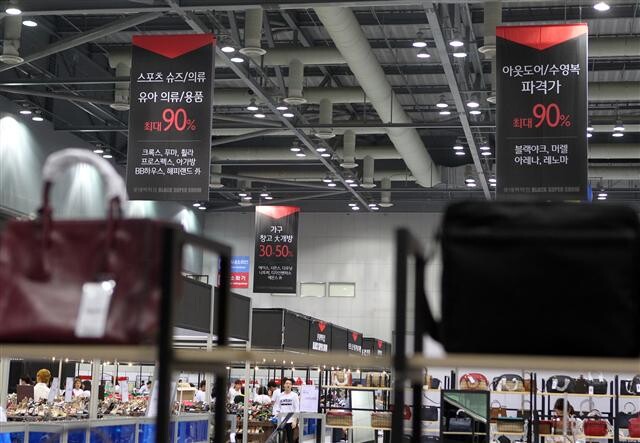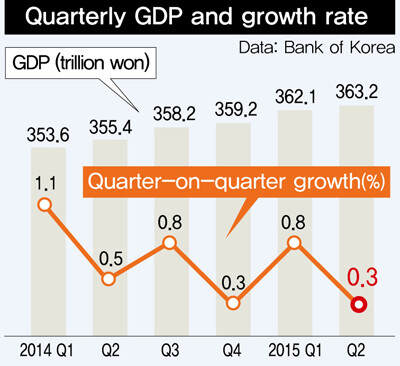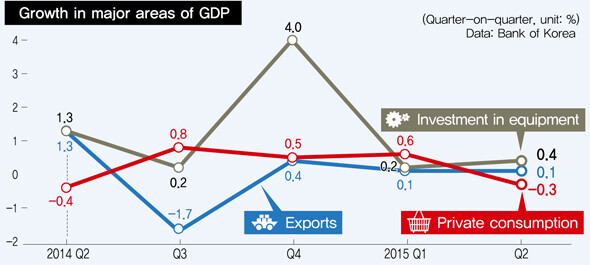hankyoreh
Links to other country sites 다른 나라 사이트 링크
S. Korean economy sputtering, falling short of growth projections

In the second quarter of this year, the South Korean economy only grew 0.3% compared to the previous quarter. This was the lowest level of growth in six years, since the first quarter of 2009 (0.1%), during the global financial crisis.
While the Middle East Respiratory Syndrome (MERS) and the drought were unexpected developments that had negative effects, the “growth shock” in the second quarter materialized as the country’s growth potential weakened on the back of a slump in exports and domestic demand. As a consequence, there are concerns that South Korea’s growth rate may not even meet the Bank of Korea’s projection of 2.8%, let alone the government’s target of 3.1%.

According to figures released by the Bank of Korea on July 23, South Korea’s real GDP for the second quarter increased by 0.3% from the previous quarter. For the fifth consecutive quarter since the growth rate fell to 0.5% in the second quarter last year following the sinking of the Sewol ferry, the growth rate has stayed below 1%.
The second quarter growth rate of 0.3% is the same as the fourth quarter of last year, when a shortfall in tax revenues led to a fiscal cliff. In the past 10 years the only quarters with growth lower than that were the fourth quarter of 2008 (-3.3%) and the first quarter of 2009 (0.1%), in the aftermath of the global financial crisis.
To explain the sharp decline in the growth rate for the second quarter, the Bank of Korea cited the temporary shocks of MERS and the drought and the structural factor of declining exports. Indeed, consumption in the private sector fell 0.3% compared with the previous quarter as spending contracted because of MERS and the number of foreign tourists decreased.
This is the first time that private consumption has faltered since the second quarter of last year (-0.4%), when spending patterns were interrupted by the Sewol tragedy.
Decline in output across a wide swath of the service sector - including wholesale, retail, dining and accommodations (-0.5%), transportation and storage (-1.3%), and health and social welfare (-1.7%) - was influenced by MERS, the Bank of Korea said.
“The MERS outbreak had a considerable effect on the growth rate. We found that consumers were willing to spend less on entertainment, food, transportation, and accommodations, while domestic consumption by foreign visitors fell considerably,” said Chun Seung-cheol, chief of the bank’s bureau of economic statistics.
As a result of the drought, production in the agriculture, forestry, and fishing sectors plunged by 11.1% compared to the previous sector. This was the biggest drop since the first quarter of 1990 (-16.8%).
Another factor that dragged down the growth rate was exports, which only increased by 0.1% in the second quarter. Exports have entered a structural slump, with the Chinese economy slowing and demand decreasing for processing and intermediary trade. Growth in exports was the same in the first quarter of this year - up 0.1% quarter on quarter.

Since the third quarter of 2014, net exports - the difference of exports and imports - has had a negative contribution to economic growth. While exports have long driven growth in the South Korean economy, they are now so poor that they are eating into that growth.
Even worse, the outlook for the second half of the year is far from rosy. The South Korean government says that, if it takes steps to stimulate the economy with a 22 trillion won (US$18.97) financial aid package, including the supplementary budget, it can reach a growth rate above 3%. But there is no reason to think that the exports and spending will recover from the slump, even if the country begins to shake off the effect of MERS and the drought in the third quarter.
There are also a number of overseas risk factors that will increase uncertainty for the South Korean economy, including rising interest rates in the US and concerns about a recession in the Chinese economy.
It is highly unrealistic that the economy will even reach the Bank of Korea’s projected growth rate of 2.8%, since this would require the economy to grow by 1.1% in both the third and fourth quarters.
“Ballooning household debt and other factors that sharply decrease consumer spending are becoming entrenched, and there are other major risk factors in the second half of the year, including financial uncertainty in China and an interest rate hike in the US,” said Kang Gyeong-hun, economics professor at Dongguk University.
“It is important for the government to find and eliminate risk factors that seriously harmed the economy and make rational structural reforms instead of rashly trying to stimulate the economy, since previous stimulus packages have not made a clear difference before.”
By Kim Su-heon and Hong Seok-jae, staff reporters
Please direct questions or comments to [english@hani.co.kr]

Editorial・opinion
![[Column] Park Geun-hye déjà vu in Yoon Suk-yeol [Column] Park Geun-hye déjà vu in Yoon Suk-yeol](https://flexible.img.hani.co.kr/flexible/normal/500/300/imgdb/original/2024/0424/651713945113788.jpg) [Column] Park Geun-hye déjà vu in Yoon Suk-yeol
[Column] Park Geun-hye déjà vu in Yoon Suk-yeol![[Editorial] New weight of N. Korea’s nuclear threats makes dialogue all the more urgent [Editorial] New weight of N. Korea’s nuclear threats makes dialogue all the more urgent](https://flexible.img.hani.co.kr/flexible/normal/500/300/imgdb/original/2024/0424/7317139454662664.jpg) [Editorial] New weight of N. Korea’s nuclear threats makes dialogue all the more urgent
[Editorial] New weight of N. Korea’s nuclear threats makes dialogue all the more urgent- [Guest essay] The real reason Korea’s new right wants to dub Rhee a founding father
- [Column] ‘Choson’: Is it time we start referring to N. Korea in its own terms?
- [Editorial] Japan’s rewriting of history with Korea has gone too far
- [Column] The president’s questionable capacity for dialogue
- [Column] Are chaebol firms just pizza pies for families to divvy up as they please?
- [Column] Has Korea, too, crossed the Rubicon on China?
- [Correspondent’s column] In Japan’s alliance with US, echoes of its past alliances with UK
- [Editorial] Does Yoon think the Korean public is wrong?
Most viewed articles
- 1[Column] Park Geun-hye déjà vu in Yoon Suk-yeol
- 2Thursday to mark start of resignations by senior doctors amid standoff with government
- 3[Editorial] New weight of N. Korea’s nuclear threats makes dialogue all the more urgent
- 4Will NewJeans end up collateral damage in internal feud at K-pop juggernaut Hybe?
- 5Why Korea shouldn’t welcome Japan’s newly beefed up defense cooperation with US
- 6[Guest essay] The real reason Korea’s new right wants to dub Rhee a founding father
- 7Kim Jong-un expressed ‘satisfaction’ with nuclear counterstrike drill directed at South
- 8[Column] ‘Choson’: Is it time we start referring to N. Korea in its own terms?
- 9N. Korean hackers breached 10 defense contractors in South for months, police say
- 10[Column] Yoon’s first 100 days should open our eyes to pitfalls of presidential system